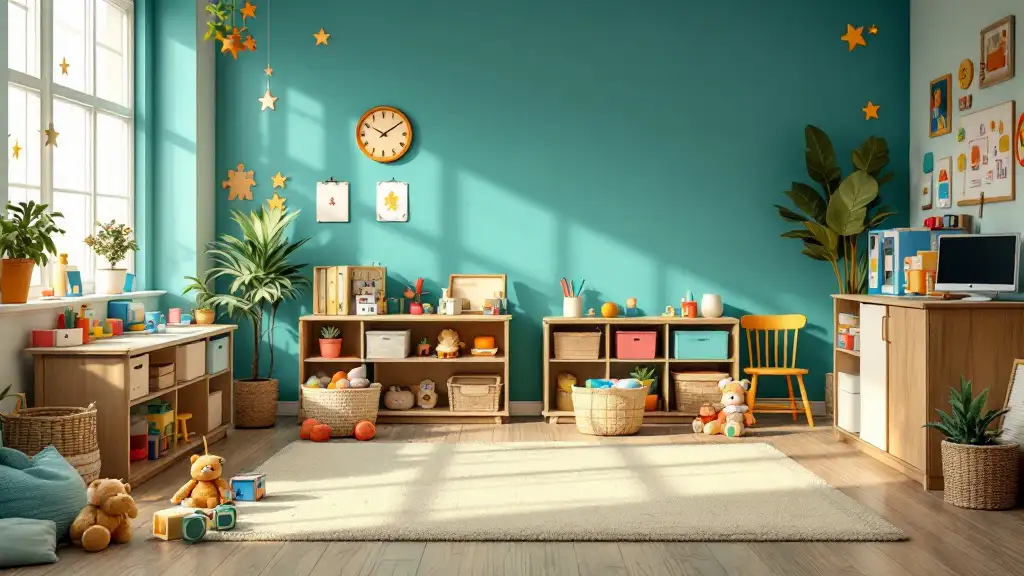What Is Play Therapy For Autism?
Unlocking Growth Through Play: A Holistic Approach for Autism Support

Understanding Play Therapy in the Context of Autism
Play therapy is an innovative and child-centered approach that leverages the natural propensity of children to learn and communicate through play. Particularly for children with autism spectrum disorder (ASD), play therapy provides a safe, engaging environment to address social, emotional, and behavioral challenges. Unlike traditional behavioral interventions, play therapy emphasizes emotional expression, relationship building, and sensory integration, making it a versatile tool in developmental support.
Defining Play Therapy for Children with Autism
What is play therapy and how does it work for children with autism?
Play therapy is an intuitive therapeutic approach centered around children's natural ways of learning, communicating, and processing their emotions through play. It provides a nurturing environment where children can freely express themselves, explore feelings, and develop essential social and emotional skills.
For children with autism, play therapy is adapted to meet their specific challenges. Often, children on the spectrum experience difficulties with communication, social interactions, and emotional regulation. Play therapy addresses these issues by utilizing specialized techniques, such as sensory activities, role-playing, and structured or child-centered play that align with each child's unique needs.
Various types of play therapy—including Floortime, Child-Centered Play Therapy, and structured play—are employed depending on the child's developmental level and preferences. These methods involve engaging children with toys, activities, and interaction styles that promote skill acquisition, emotional growth, and social understanding.
One of the main goals of play therapy is to encourage children to develop problem-solving abilities, sharing, cooperation, and sensory processing skills. It often involves caregivers and family members, who are guided to reinforce learning and progress at home.
The core idea is to use play as a natural language, making therapy sessions both enjoyable and effective. Children are motivated to participate because activities are aligned with their interests, reducing anxiety and increasing engagement.
How does play therapy facilitate self-expression?
Children with autism might find it difficult to communicate their thoughts and feelings verbally. Play therapy provides an alternative outlet, allowing children to express themselves non-verbally through toys, role play, storytelling, and creative activities.
During therapy, children can act out experiences, simulate social interactions, or explore sensory experiences, helping therapists understand their internal world. This process helps children recognize and regulate their emotions, identify their needs, and build confidence.
Parents and therapists observe play behaviors to identify underlying emotions and thoughts, guiding targeted interventions. As children gain trust and develop emotional awareness through play, they learn to communicate more effectively and build meaningful relationships.
Use of toys, activities, and interaction techniques
Play therapy employs a diverse range of tools to facilitate development:
| Tools and Activities | Description | Purpose |
|---|---|---|
| Toys and Minifigures | Action figures, dolls, sensory toys, and puzzles | To encourage symbolic play, storytelling, and social role-playing |
| Sensory Activities | Play with textures, lights, sounds, and tactile materials | To address sensory processing issues and promote calmness |
| Art and Creative Supplies | Drawing, painting, and craft projects | To foster self-expression and emotional processing |
| Role-Playing and Storytelling | Using dolls or puppets, enact stories and scenarios | To develop language skills, empathy, and perspective-taking |
| Structured Games | Turn-taking games, matching, and problem-solving activities | To improve social rules understanding and cognitive flexibility |
Interaction techniques include establishing trust through consistent routines, actively engaging in the child's chosen activities, providing positive reinforcement, and reflecting children’s feelings to foster understanding. Therapists may use both directive strategies (guiding specific activities) and nondirective approaches (allowing children to lead), creating a balanced environment that supports individual growth.
In conclusion, play therapy utilizes toys, activities, and interaction tools to create an engaging and supportive space where children with autism can express themselves freely, develop crucial skills, and foster emotional resilience. This approach recognizes play as a vital language for children and a powerful avenue for therapeutic progress.
How Play Therapy Facilitates Development in Children with Autism
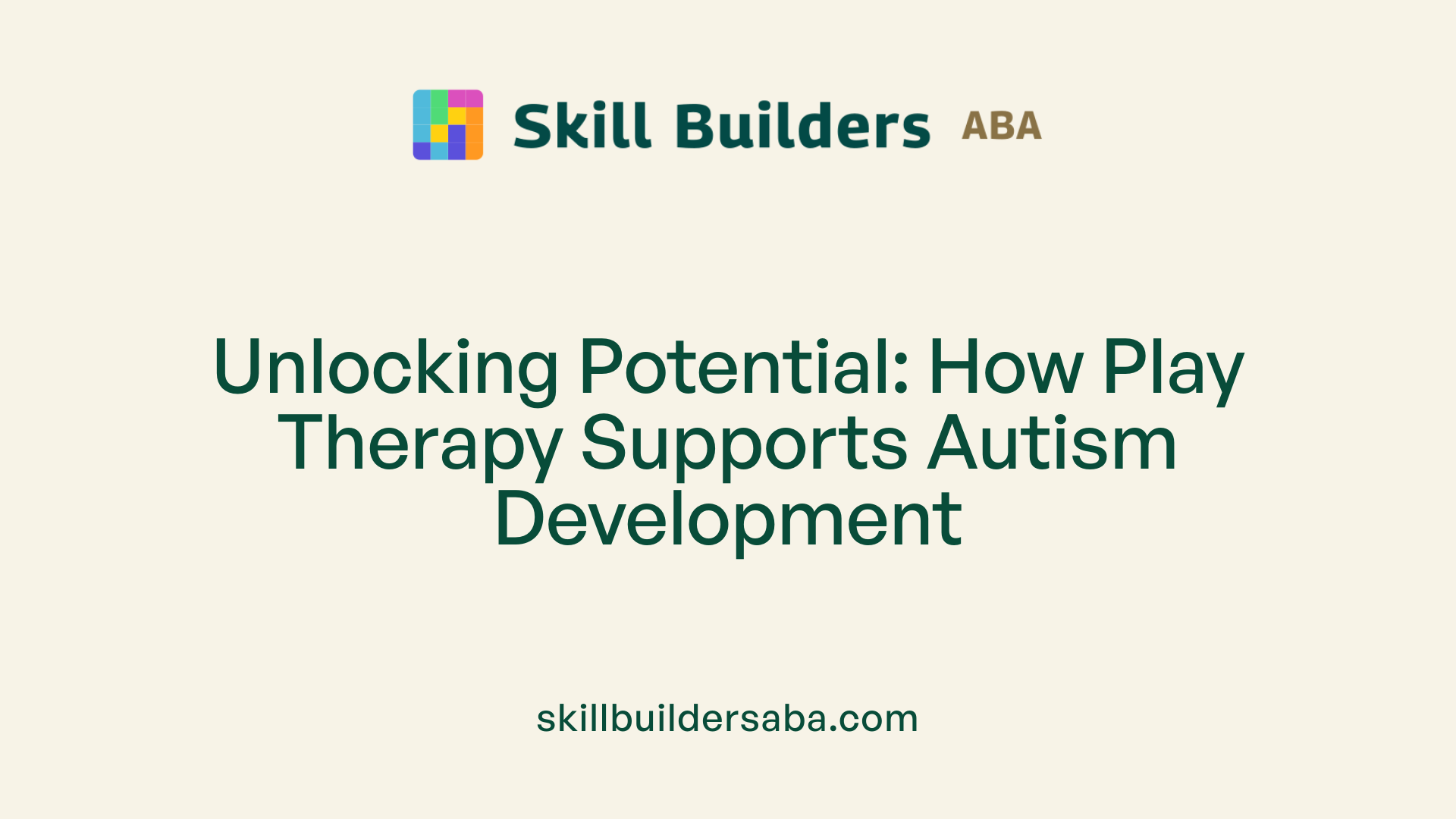
What is play therapy and how does it work for children with autism?
Play therapy is a gentle, engaging approach that taps into children's natural love for play, offering them a safe space to express feelings, practice social skills, and improve communication. For children with autism, this method incorporates activities like sensory play, role-playing, storytelling, and structured or child-centered play, designed to meet their unique developmental needs.
Different variations of play therapy, such as Floortime or Child-Centered Play Therapy, allow children to direct their own play or follow guided activities aimed at emotional and social growth. These sessions often involve toys, arts and crafts, and interactions tailored to encourage interaction, problem-solving, and sensory regulation.
The goal is to develop a variety of skills including emotional regulation, social understanding, and communication. Play encourages children to explore their environment, connect with others, and discover new ways of expressing themselves. Typically, families are involved in the process, helping reinforce learned skills at home.
Overall, play therapy leverages enjoyable activities to foster progress across multiple areas, addressing autism-related challenges by promoting neural connections, emotional resilience, and social competence.
Benefits of Play Therapy for Children with Autism
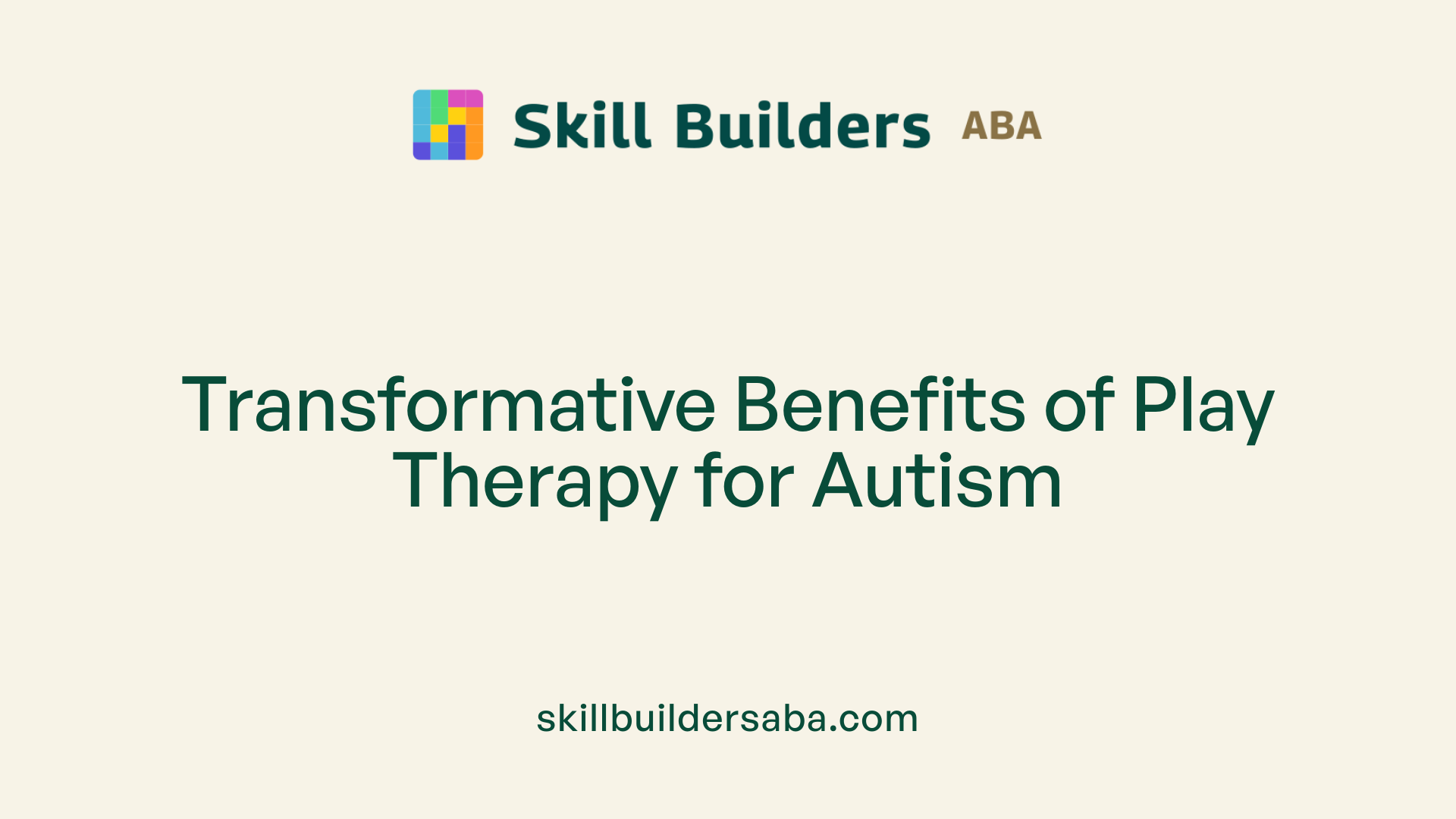
What are the benefits of play therapy for children with autism?
Play therapy provides multiple advantages for children on the autism spectrum. It helps support their emotional, social, and behavioral growth by offering a safe space for self-expression. Through play, children can engage in activities and use toys that they naturally prefer, which encourages them to communicate and connect.
One of the primary benefits is the development of social skills such as turn-taking, sharing, and understanding nonverbal cues. Techniques like floor time and joint attention activities are commonly used to promote these abilities, helping children improve their interaction with peers and adults.
Furthermore, play therapy enhances communication skills. For children with limited verbal abilities, it offers alternative ways to express themselves through actions, gestures, and play narratives. As they better understand and use language, their ability to relate to others improves.
Emotional regulation and stress reduction are also notable outcomes. By creating a calming, predictable environment, play therapy helps children manage anxiety and emotional upsets. They learn to recognize and cope with feelings, fostering resilience and emotional well-being.
Developmental progress in motor and sensory skills is another important aspect. Structured and sensory play activities support coordination, fine motor control, and sensory processing, which are often areas of difficulty for children with autism.
Involving family in play therapy sessions helps strengthen bonds and provides parents with strategies to reinforce skills at home. This consistent involvement promotes a supportive environment that accelerates developmental gains.
While research on play therapy’s effects is still emerging, evidence suggests it can address core ASD symptoms, induce positive changes in brain connectivity related to social interaction, and improve overall adaptive functioning. Although more rigorous studies are needed, current observations highlight play therapy’s potential to foster meaningful social, emotional, and developmental progress in children with autism.
Summary Table:
| Benefit Area | Description | Supporting Techniques |
|---|---|---|
| Social Skills | Improved peer interaction, turn-taking, understanding nonverbal cues | Floortime, social groups, peer play |
| Communication | Enhanced expressive and receptive language, alternative communication pathways | Role-playing, storytelling, symbolic play |
| Emotional Regulation | Better stress management, emotional awareness, and coping | Sensory activities, safe expressive outlets |
| Motor and Sensory Skills | Gains in coordination, sensory processing, and fine motor control | Sensory play, structured activities |
In conclusion, play therapy offers a flexible, engaging approach that can significantly benefit children with autism, promoting their social, emotional, and cognitive development while strengthening family involvement. The tailored activities and safe environment help children build essential skills, making it a valuable part of a comprehensive intervention plan.
Various Types of Play Therapy Tailored for Autism
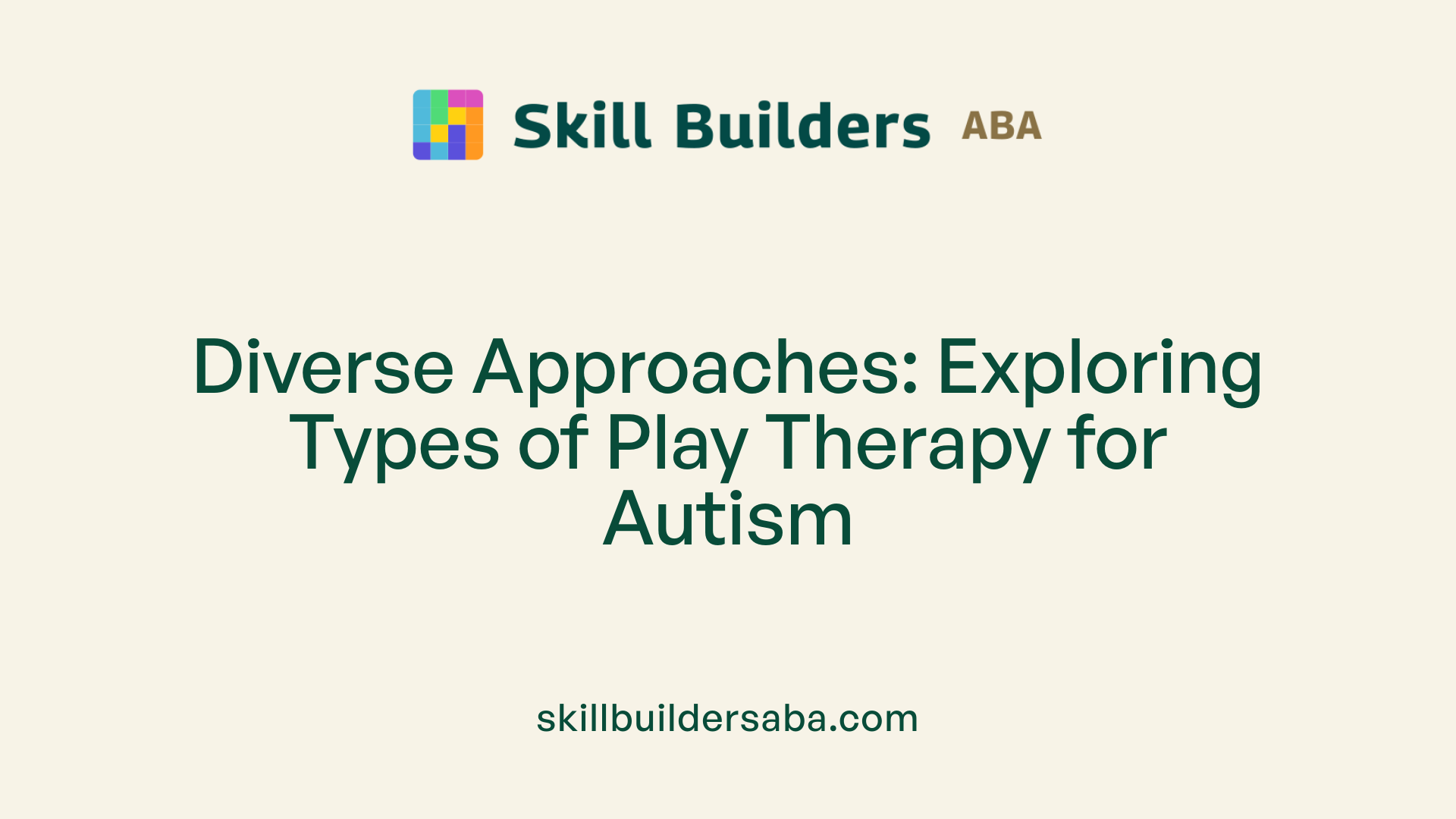
What are the different types of play therapy used for autism?
Children with autism often face unique challenges in communication, social interaction, and sensory processing. To address these needs, various forms of play therapy are employed, each designed to foster emotional growth, improve social skills, and enhance communication.
Child-centered Play Therapy is one of the most common approaches, emphasizing the child's natural preferences and pace. In this non-directive method, children lead the play, with the therapist providing a supportive presence. This approach allows children to express feelings freely, explore their emotions, and build trust. Techniques such as Parallel Play, Unconditional Positive Regard, and Reflective Listening help in understanding the child's inner world.
Floortime and DIR Approaches focus on developmental levels, engaging children on their emotional and social stages. During Floortime sessions, therapists or caregivers play with children on the floor, encouraging engagement through activities that are interesting to the child. This method promotes shared attention, emotional regulation, and social reciprocity, helping children develop foundational relationship-building skills.
Art and Sensory Play Therapies incorporate hands-on activities like drawing, sculpting, or tactile play with sensory materials such as sand, water, or textured fabrics. These help children express feelings non-verbally, improve sensory integration, and develop fine motor skills. Art therapy can also serve as a calming tool, reducing anxiety and fostering emotional insights.
Equine-Assisted and Group Play Methods expand social opportunities in natural settings. Equine therapy involves interactions with horses, which can enhance emotional regulation and trust. Group play therapy facilitates peer interaction, teaching turn-taking, sharing, and cooperative problem-solving, which are vital for social development.
Structured versus Unstructured Play Sessions are tailored based on the child's needs. Structured play involves specific tasks and goals, such as building with blocks or following a sequence, to develop cognitive skills and understanding rules. Unstructured or free play allows children to explore creatively, promoting spontaneity and emotional expression.
These varied play therapies are often combined or adapted, incorporating sensory integration activities, role-playing, storytelling, and interactive games. They use special tools such as visual aids, social stories, and sensory toys to support communication and sensory regulation.
The common goal across all these approaches is to create a safe, engaging environment where children can explore, learn, and connect. Therapists continuously observe and modify activities, ensuring they align with each child's developmental level and personal interests. Importantly, family involvement often enhances the effectiveness, with parents learning techniques to reinforce skills at home.
Overall, diverse play therapy methods aim to unlock children's potential by fostering self-expression, encouraging social and emotional skills, and promoting overall well-being in a supportive, playful setting.
Comparison of Play Therapy With Other Autism Interventions
How does play therapy compare with other autism treatments like ABA?
Play therapy and Applied Behavior Analysis (ABA) are both prominent interventions for children with autism, but they have distinct purposes and methods. ABA is a highly structured approach rooted in behaviorism. It focuses on understanding behavior and using positive reinforcement to teach specific skills and reduce problematic behaviors. The therapy involves systematic assessments, individualized programs, and often one-on-one instruction, with measurable goals such as increasing communication or social skills.
Play therapy, on the other hand, is more flexible and child-centered. It emphasizes emotional expression, social development, and emotional regulation through guiding or allowing free play. The goal is to create a safe, nurturing environment where children can explore their feelings, develop relationships, and learn coping strategies. Techniques include role-playing, storytelling, sensory activities, and pretend play, often tailored to the child's individual interests and developmental level.
Distinct goals and methods
While ABA aims to teach specific behaviors and skills through repetition and reinforcement, play therapy aims to foster overall emotional well-being and social understanding. ABA is outcome-focused, often targeting measurable skills like language use or self-care routines, whereas play therapy concentrates on emotional expression, relationship building, and improving communication through symbolic and imaginative play.
The methods differ significantly. ABA involves structured routines, data collection, and reinforcement schedules, with clear behavioral objectives. Play therapy uses more open-ended activities, reflecting the child's interests, and relies on observing and facilitating emotional and social growth.
Complementary nature and integration possibilities
Despite their differences, the two therapies can complement each other effectively. ABA can instill foundational skills such as communication, self-control, and daily living routines. Play therapy can then build on these skills by helping children apply them in social and emotional contexts.
Integrated treatment plans combine behavioral techniques with emotional and social interventions. For example, a child might learn language skills through ABA, while use of play therapy sessions fosters emotional regulation and social responsiveness.
Healthcare providers often advocate for a multidisciplinary approach, where different therapies address various aspects of autism spectrum disorder. Combining structured skill-building with emotional support offers a more holistic development pathway.
Advantages and limitations
Advantages:
- ABA's strength lies in its empirical evidence, effectiveness in teaching specific skills, and reducing problematic behaviors.
- Play therapy offers an engaging, less intimidating environment for children to express themselves, especially those with communication challenges.
- Both therapies can be tailored to individual needs and developmental levels.
Limitations:
- ABA can be perceived as rigid and intensive, potentially causing stress for some children.
- Play therapy, although promising, currently has limited rigorous scientific evidence to confirm its widespread efficacy; most supporting data are based on small case studies.
- Optimal results often come from combining approaches, which requires careful coordination and skilled professionals.
| Aspect | Play Therapy | ABA | Similarities | Differences |
|---|---|---|---|---|
| Goals | Emotional expression, social skill development | Skill acquisition, behavior reduction | Both aim to improve functioning | Different focuses: emotional vs. behavioral |
| Methods | Play activities, imaginative and sensory play | Structured routines, reinforcement | Both involve individualized plans | Approach: child-led vs. therapist-led |
| Evidence Base | Limited, mostly case studies; promising but needs more research | Strong, well-documented efficacy | Both are evidence-informed | Core philosophy and implementation |
| Suitability | Emotional regulation, communication challenges, social behavior | Skill deficits, behavioral issues | Both can be personalized | Underlying philosophy: emotional vs. skills focus |
In conclusion, play therapy and ABA serve different but often complementary roles in supporting children with autism. Understanding their unique characteristics allows caregivers and professionals to design comprehensive, tailored intervention plans that address both the emotional and developmental needs of each child.
Supporting Social and Emotional Growth Through Play
How can play therapy support the social, emotional, and behavioral development of autistic children?
Play therapy serves as a valuable tool for nurturing the social, emotional, and behavioral growth of children with autism. It provides a safe and engaging environment where children can freely express their feelings and thoughts through play, which is often their most natural form of communication.
Through tailored activities like role-playing, storytelling, sensory play, and social skills groups, children learn to manage their emotions better and develop vital social skills. For example, they practice turn-taking, sharing, and understanding nonverbal cues such as facial expressions and gestures, which are often challenging for children with autism.
One of the central benefits of play therapy is its ability to enhance self-awareness and empathy. Activities are designed to help children recognize their own feelings, understand others’ emotions, and respond appropriately. This emotional regulation development helps reduce aggressive behaviors, anxiety, and emotional outbursts.
Play therapy also encourages problem-solving and creative thinking, supporting children in gaining confidence and independence. As children explore different scenarios and practice social interactions within a safe space, these skills often transfer to their daily lives, improving their ability to navigate real-world social situations.
Different approaches within play therapy—such as art-based play, sensory integration, or joint attention exercises—are used to address individual developmental challenges. For instance, therapies like Floortime emphasize following the child's lead to foster connection and emotional growth, while social skills groups promote peer interactions.
Furthermore, play therapy enhances the capacity for children to connect with caregivers and peers, strengthening relationships and fostering a sense of trust and security. This relational aspect not only benefits the child's immediate development but also supports long-term social and emotional resilience.
In summary, play therapy offers a comprehensive framework to help children with autism develop crucial social behaviors, emotional understanding, and behavioral regulation that are essential for successful interactions and overall well-being. Its flexible, child-centered approach complements other therapeutic modalities, making it a versatile component of autism intervention plans.
Current Research Evidence and Future Directions in Play Therapy for Autism
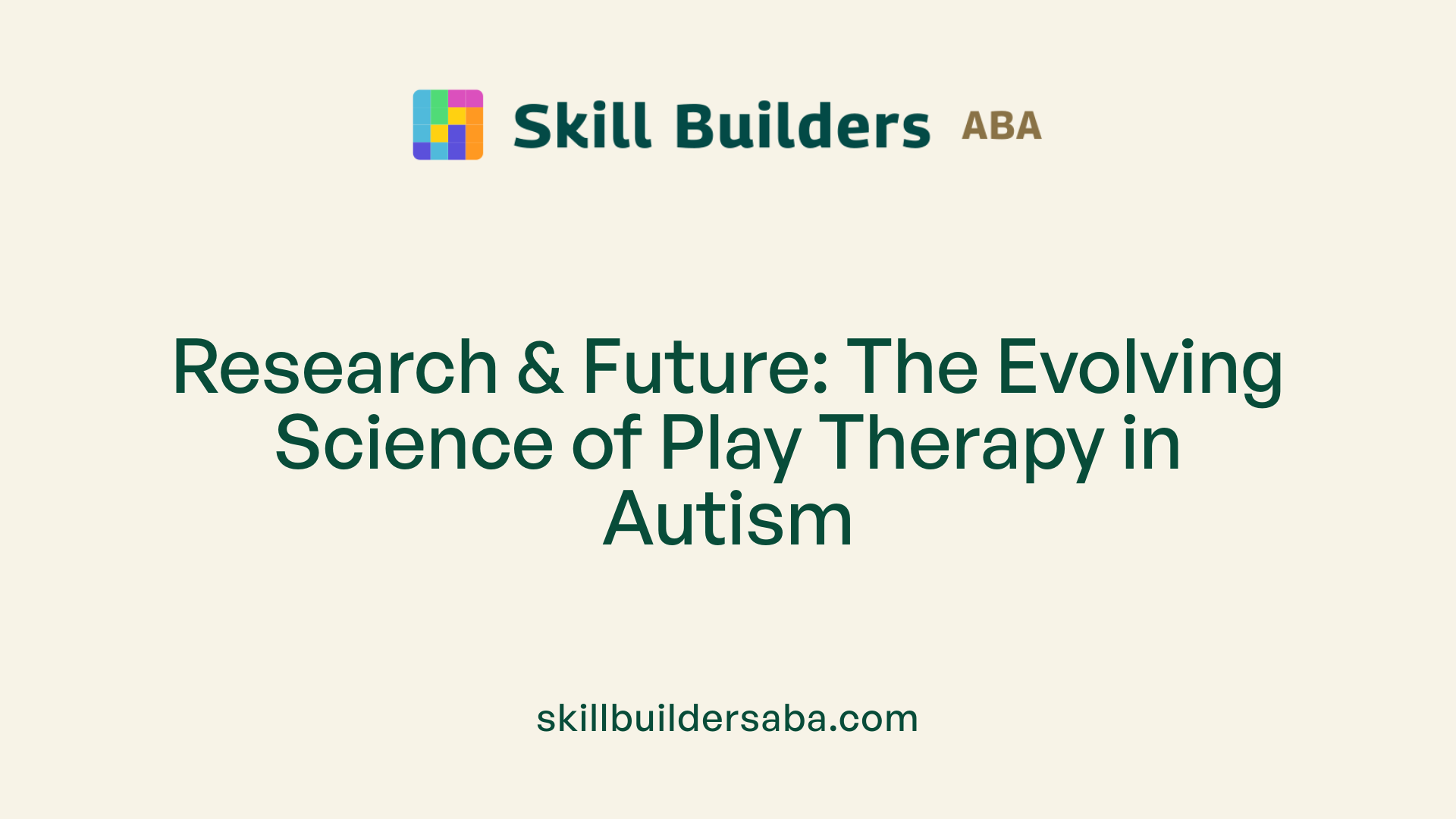
What does research say about the effectiveness of play therapy for autism?
Current studies suggest that play therapy can be beneficial for children with autism. Many case reports and small-scale research projects have documented improvements in social interaction, communication skills, and emotional regulation following play-based interventions. For instance, some evidence points to increased engagement in social activities, better emotional understanding, and reduction in maladaptive behaviors like aggression or rigidity.
Notably, several randomized controlled trials (RCTs) and neuroimaging studies support the notion that play therapy can induce neural changes in the brain. These changes are associated with enhanced social responsiveness, emotional regulation, and cognitive flexibility. For example, neuroplasticity observed through functional imaging indicates that engaging children in structured and unstructured play can promote new connections in neural pathways.
Despite these promising findings, the overall body of research is still limited in scope. Many existing studies are small, lacking in control groups or randomization, which makes it challenging to generalize results universally. Additionally, variability in therapy approaches and outcome measures adds complexity to interpreting the existing evidence.
Limitations of current research
The current research landscape has notable gaps. Many studies face methodological challenges such as small sample sizes, high risks of bias, and inconsistent definitions of what constitutes 'play therapy' in studies. These limitations hinder the ability to firmly establish the effectiveness of different play therapy modalities across diverse populations.
Moreover, most existing research focuses on short-term outcomes, with fewer investigations into the long-lasting effects of play therapy. There’s also variability in the age ranges, severity levels of autism, and the types of play interventions used, which further complicates drawing definitive conclusions.
Potential neuroplastic benefits
One of the exciting aspects of play therapy is its potential to promote neuroplasticity. When children engage in play activities tailored to their developmental needs, their brains can form new connections. Neuroimaging studies indicate that such interventions may support neural pathways involved in social cognition, emotion regulation, and sensory processing.
The ability of play therapy to induce such changes enhances its appeal as a holistic approach that not only addresses behavioral symptoms but also targets underlying neural mechanisms. This growing body of neurological evidence complements behavioral observations, reinforcing play therapy’s potential as a neural and psychological intervention.
Need for rigorous future research
Despite encouraging preliminary evidence, there’s an urgent need for more rigorous scientific investigations. Future studies should employ larger sample sizes, standardized treatment protocols, and control conditions to better assess effectiveness.
Randomized controlled trials with long-term follow-up are crucial to determine the sustainability of gains made through play therapy. Incorporating objective measures, such as neuroimaging and neurophysiological assessments, could strengthen evidence for neuroplastic changes.
Moreover, ongoing research should explore which specific types of play therapy work best for different subgroups within the autism spectrum, considering factors like age, severity, and co-occurring conditions.
Training and expanding access
To maximize benefits, there’s also a need to expand training for professionals in various play therapy modalities. Increasing the number of qualified practitioners can improve accessibility, especially in underserved areas.
Additionally, integrating remotely delivered play therapy (tele-play therapy) has gained importance, particularly during circumstances like the COVID-19 pandemic. This approach can bridge geographical gaps and make therapy more accessible to families who might otherwise face barriers.
Efforts should focus on developing standardized training curricula and certification programs to ensure quality and consistency of therapy delivery.
| Aspect | Current Status | Recommendations |
|---|---|---|
| Evidence Strength | Limited, mainly observational and small RCTs | Conduct larger, multi-center RCTs |
| Neuroplastic Evidence | Emerging via neuroimaging | Expand neuroimaging studies to confirm neural mechanisms |
| Therapy Access | Variable, with some remote options | Implement widespread training, promote tele-therapy |
| Research Needs | Better controlled and standardized studies | Prioritize randomized, long-term investigations |
Future directions in play therapy research must focus on rigorous validation, understanding neural effects, and broadening access. As evidence accumulates, this approach can become a vital component of holistic autism care.
Integrating Play Therapy into Broader Support Systems
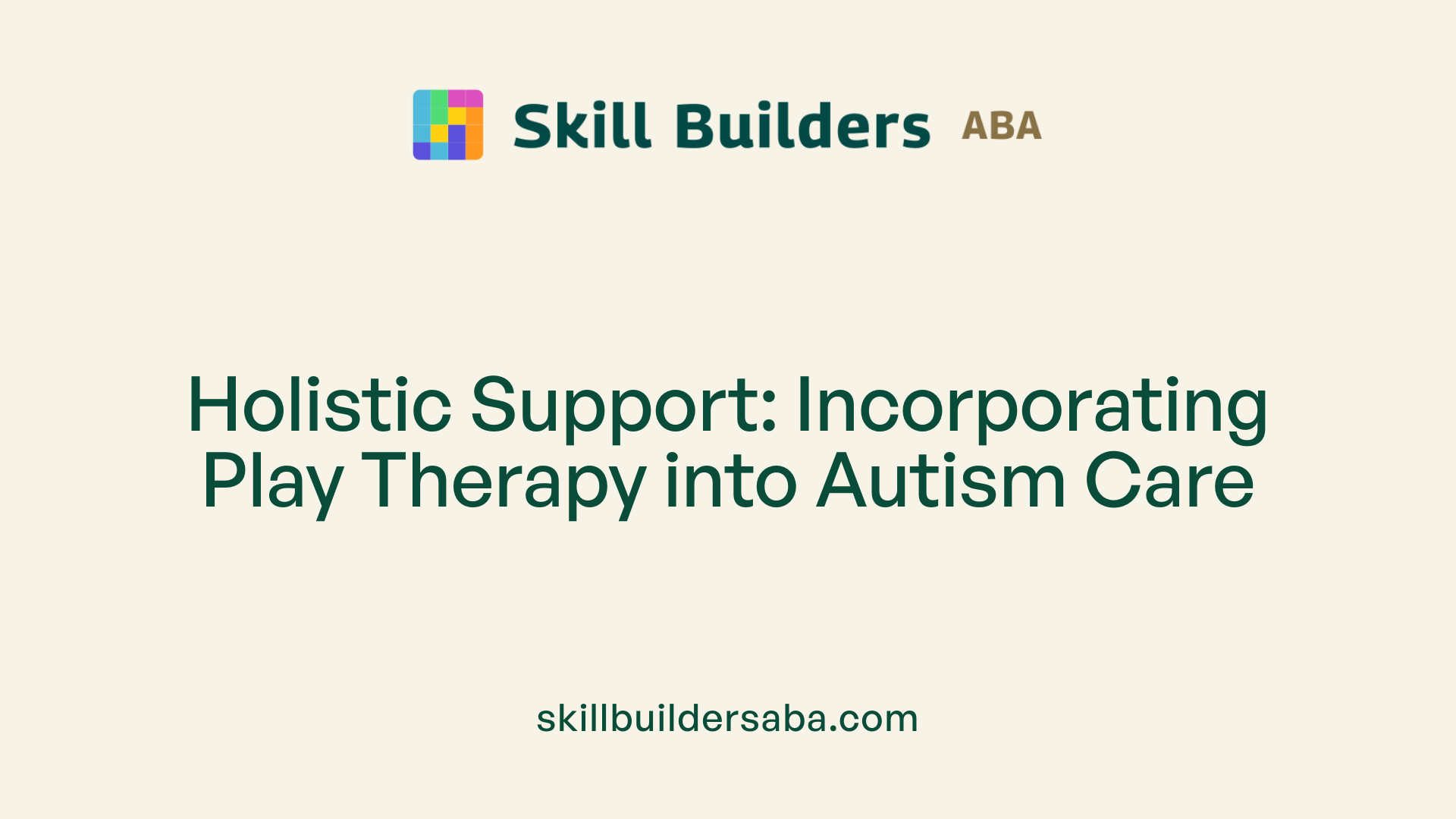
How can play therapy be integrated into healthcare and therapeutic services for children with autism?
Play therapy can be seamlessly incorporated into the overall framework of healthcare and therapeutic services for children with autism through a multidisciplinary approach. This strategy involves collaboration among various professionals such as psychologists, occupational therapists, speech therapists, and medical practitioners.
In practice, play therapy is delivered in clinics, schools, and community centers, making it accessible and adaptable to different settings. The therapy employs tailored play activities—ranging from sensory exploration to structured and expressive play—to meet each child's unique needs.
Specific techniques like Floortime, which encourages emotional and social development by playing at the child's level, and interventions aiming to improve joint attention and communication, are frequently used. Some programs also include innovative methods such as equine-assisted play therapy, which promotes physical coordination and social interaction.
An essential component of effective integration is the active involvement and training of parents and caregivers. They are coached on ways to reinforce play therapy strategies at home, ensuring that skills learned are generalized to everyday situations.
The ultimate goal of integrating play therapy into broader services is to support neuroplasticity, emotional regulation, and social engagement. This integration enhances the child’s development while fostering trust and decreasing core challenges associated with autism.
In summary, play therapy, when effectively embedded within a multidisciplinary care system, offers a low-risk, evidence-informed means to strengthen emotional, social, and communication skills, addressing fundamental issues faced by children with autism and promoting their overall well-being.
Guidance for Parents and Caregivers Considering Play Therapy
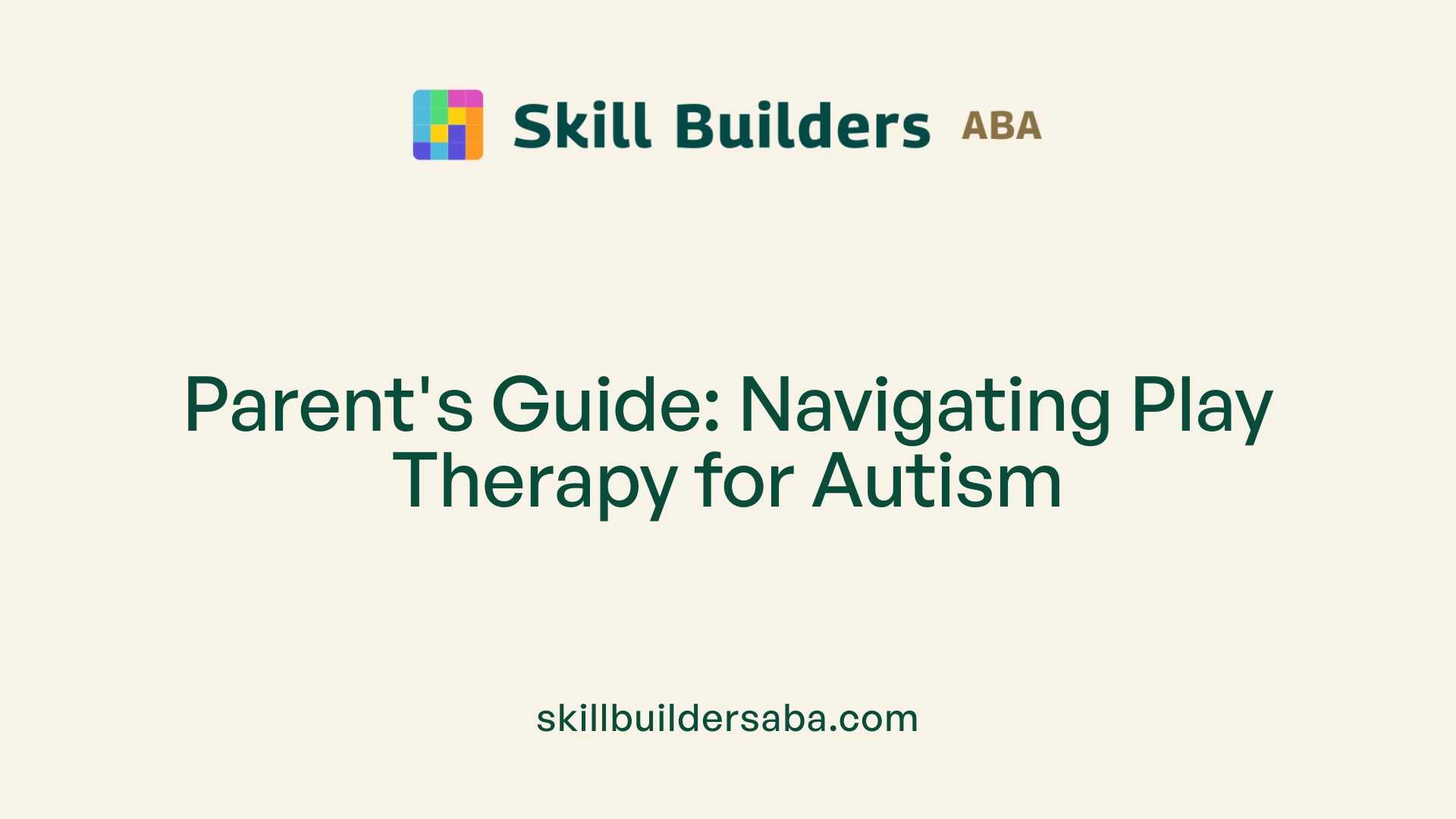
What guidance and resources are available for parents and caregivers considering play therapy options for autistic children?
When exploring play therapy as a treatment option for children on the autism spectrum, parents and caregivers should begin by consulting with licensed professionals who have specialized training in child-centered and neurodiversity-affirming approaches. These trained specialists, such as certified play therapists, are equipped to tailor interventions to meet the unique needs of each child.
It is beneficial to understand the different types of play therapy available. For example, Child-Centered Play Therapy (CCPT) emphasizes a relationship-based, non-directive approach that allows children to lead in their play, fostering emotional expression and social skills. On the other hand, approaches like Floortime or DIR focus on developmentally appropriate engagement to promote emotional and social growth. Some programs, such as AutPlay® Therapy, are specifically designed for neurodivergent children, emphasizing strengths-based strategies and sensory integration.
Parents should tap into local resources by researching programs offered within hospitals, clinics, and community centers. Support networks, including parent groups and online forums, can provide valuable encouragement and share experiences with other families. Many organizations offer Parent’s Guides, informational sessions, and workshops to help families understand the benefits and practical aspects of play therapy.
Assessing the individual child's needs is critical. This involves consultations with multidisciplinary teams that include speech-language pathologists, occupational therapists, and behavioral specialists. Proper evaluations help identify specific challenges and strengths, ensuring that the chosen therapy aligns with the child's developmental level, sensory preferences, and communication abilities.
Utilizing available online resources—such as websites with comprehensive lists of qualified therapists—can aid in finding reputable providers. Search queries like "Play therapy resources for parents of children with autism" often lead to curated guides and directories.
In summary, navigating the options for play therapy involves a combination of professional guidance, understanding different therapeutic modalities, leveraging community and online resources, and conducting thorough assessments to tailor interventions that best support each child's emotional, social, and developmental growth.
The Path Forward in Play Therapy for Autism
As awareness of autism and therapeutic options progresses, play therapy continues to evolve as a vital component of holistic support systems. Its flexible, engaging, and child-centered nature makes it an appealing choice for many families and practitioners. While research is ongoing to establish definitive efficacy, existing evidence underscores its potential to profoundly impact emotional, social, and behavioral development. Integrating play therapy alongside evidence-based approaches like ABA, occupational, and speech therapies offers a comprehensive pathway to support children with autism in achieving their full potential. Empowered with better resources, professional training, and family involvement, the future of play therapy holds promise for fostering meaningful growth, resilience, and joyful discovery for children with ASD.
References
- Play therapy in children with autism: Its role, implications, and ...
- Play Therapy for Autism: Benefits, Techniques & Tips - Forbrain
- Play Therapy's Role in Pediatric Autism Services for Kids
- Which Therapies Can Help with Autism? - WebMD
- Play Therapy For Autism: What Parents Need to Know - Blue ABA
- ABA vs. Play Therapy: Which is Better for Your Child?
- Is Play Therapy an Evidenced-Based Intervention for Children with ...
- Exploring the Techniques of Child-Centered Play Therapy
- Reducing Anxiety in Children with Autism with Play Therapy
.svg)














